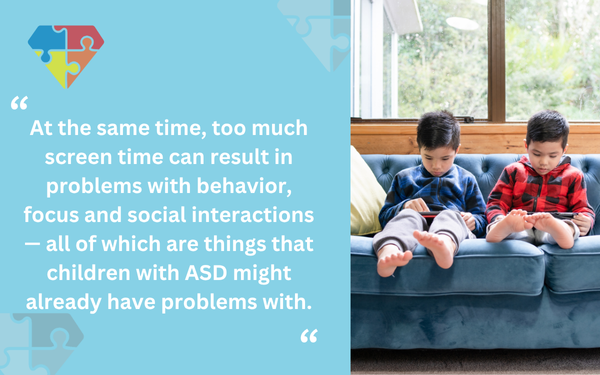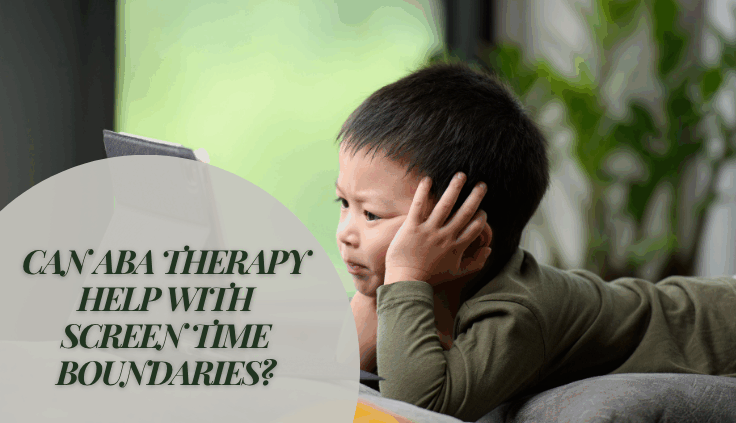Can ABA Therapy Help with Screen Time Boundaries?
Managing screen time can be a big challenge for parents today, especially since they are found everywhere. TVs, smartphones, computers and tablets are omnipresent and a critical part of everyday life.
These technologies help make our lives easier, whether it be doing work, learning or communicating with others. They can also be great sources of entertainment, and it’s something that children are particularly drawn to.
Having an excess of screen time can be detrimental to children, though, as it can negatively affect their physical activity levels, sleep and social skills. This is a particularly tough challenge for children with autism spectrum disorder (ASD), who may be more drawn to screens and hyperfocused on them than their neurotypical peers.
Managing screen time and setting up boundaries are important for children with autism.
Following the principles of applied behavior analysis (ABA therapy), therapists can help with screen time boundaries. Here are some ways how.
Table Of Contents
Why Is Too Much Screen Time a Problem?
Technology can be an extremely helpful and impactful tool. There are many great education programs and apps that can be found online, for instance, and there are even tools that help children with autism communicate better.
At the same time, too much screen time can result in problems with behavior, focus and social interactions — all of which are things that children with ASD might already have problems with.

Screen time can make it hard for children to switch from activities on a screen to other real-world activities, can reduce their interest in interacting with other people and playing, result in more severe emotional reactions when the screen time is over, and even make it hard for them to fall asleep and stay asleep.
This is why it’s so important to set up screen time boundaries.
| Screen Time Challenge | ABA-Based Approach |
|---|---|
| Hyperfocus on screens | Use routines and clear time limits to gradually reduce screen dependence. |
| Trouble switching to non-screen activities | Introduce visual schedules and structured transitions with positive reinforcement. |
| Negative emotional reactions after screen time | Help children anticipate screen time endings with cues and reward systems. |
| Lack of physical activity | Schedule fun, physical breaks as part of daily routines to balance screen use. |
Establish Time Limits
Children with autism thrive on routine and structure. When they’re able to predict what’s going to happen when, they’re more likely to exhibit positive behaviors and feel less stressed, anxious and overwhelmed.
By working screen time into the daily schedule, it can accomplish a few things. First, it can reward your child and give them screen time that they are likely to enjoy and be engaged in.
Second, it will also equate screen time to other activities throughout the day. In other words, screen time will become a set activity rather than an open-ended escape.
By working screen time into the daily routine, you’ll be establishing time limits that are clear, and this could help children with autism manage their emotions when screen time is over.
Carefully Select the Content
Screen time can be very educational. It doesn’t have to be just about playing mindless games.
With the help of your child’s ABA therapist, you can carefully select the content your child with autism is going to consume during screen time. The content can prioritize content that helps to promote their development and overall learning.
Luckily, there are plenty of programs and apps today that are specifically designed to be used for children with ASD. THey can help them teach proper social behaviors and expand communication skills, while also addressing other developmental areas.
In this way, screen time can actually be used to help children with ASD focus better while also improving their social and communication skills. It’s important to work with the ABA therapist on cultivating this content, as it’s best if it can align with the goals your child has in ABA therapy.
Encourage Physical Activity
It’s easy for children with autism to become hyperfocused on screens. One way you can set boundaries for screen time is by encouraging physical activity.
This could involve spending time outside your house playing, walking around the block or even doing organized and controlled physical activities inside the house. Something as simple as stretching or jumping in place can provide many benefits for children.
Again, by working physical activity into the daily routine, you can make it something that your child will look forward to, as it’s a fun activity. This might help manage their screen time and any possible negative behaviors associated with ending screen time.
Blue Gems ABA Helps Children with ASD Manage Their Behaviors
Screen time can be a major problem for children with ASD. Following some of the strategies above, you and your child’s ABA therapy team can help set screen time boundaries.
At Blue Gems ABA, we work everyday to help children with autism manage their behaviors, while also building communication, social interaction and daily life skills. By crafting personalized ABA therapy plans for each child, we ensure that the treatment plan caters specifically to their strengths, challenges and preferences, which makes it more effective.
To learn more, please contact us today.




